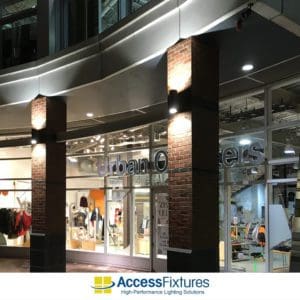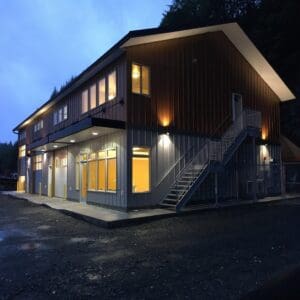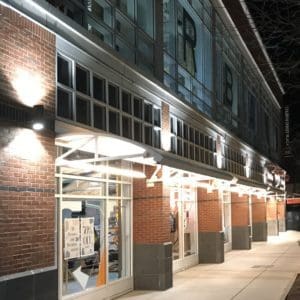What is a Building Facade?
Before embarking on LED lighting projects to illuminate building facades, knowing what a building façade is, is key. A building facade is like the face of a building. It is the exterior side that faces the street or public space. Facades include the front elevation and all its components such as doors, windows, walls, and architecture. Think of it as a building’s first impression; it often reflects the style, character, and identity of the structure. Façades can be simple or intricate, modern or classical, and they play a significant role in defining the overall aesthetic of a building. LED facade lighting can enhance these architectural features, convey messages, and contribute to the aesthetic appeal of structures.
What is Facade Lighting?
Facade lighting is a specialized form of architectural lighting designed to illuminate the exterior of buildings, highlighting their unique architectural features and creating a visually striking impact. This type of lighting is not just about aesthetics; it plays a crucial role in enhancing the building’s appearance, improving safety and security, and creating a welcoming ambiance. By strategically placing facade lights, designers can accentuate specific elements such as columns, arches, or entrances, or achieve a uniform lighting effect across the entire facade. The right facade lighting can transform a building into a nighttime landmark, making it stand out and leaving a lasting impression.
Consider the Following for Building Facade Lighting Projects
When choosing lighting fixtures for facades, the aesthetics in the architecture help transform a building’s façade from a mere structure to a captivating work of art. As technology advances, LED luminaires have emerged as the frontrunners in the world of facade illumination, offering unparalleled versatility, energy efficiency, and creative possibilities. In building facade lighting, these tiny diodes pack a punch, providing a canvas of possibilities for architects and lighting designers.
SEE HOW ACCESS FIXTURES ILLUMINATED THE WEST NEWTON ARMORY FACADE
Understanding Architectural Elements of Buildings Ahead of The Façade Lighting Project
Before the commencement of the building facade lighting project, it’s crucial to understand the architectural elements that make your building
unique. Identify key features, textures, and lines that deserve to be accentuated. This is where accent lighting comes into play by using one or more fixtures to highlight an object or objects on the structure being lit. Access Fixtures’ LED lights for facade lighting, with their directional capabilities, offer the precision needed to highlight these details. Incorporating LED facade lights can enhance both the practical illumination and the artistic aesthetics of the architecture.
Choosing the Right Color Temperature LED Light for The Building Facade Lighting Project
Color temperature sets the mood and ambiance of your building facade. Warm temperatures or light colors (e.g., 2700K) create a cozy, inviting atmosphere, while cooler temperatures (e.g., 5000K) offer a more modern and vibrant look.
Directional LED Lighting Enhances the Architecture of Facades
LED lights, including led floodlights, are masters of direction. Uplights, downlights, and spotlights can be strategically positioned to cast shadows, create depth, and emphasize architectural nuances. The play of light and shadow adds a dynamic dimension to your building’s exterior.
Building Façade Dynamic Displays with Smart Controls for LED Luminaires
Take your facade lighting to the next level with smart controls. LED lights integrated with intelligent systems allow for dynamic displays, color changes, and programmable scenes. Whether it’s a subtle transition between warm tones or a vibrant light show for a special event, smart controls provide endless possibilities.
Embracing Uniformity with Facade Lighting Design
Even illumination is key to a visually striking facade. Ensure that the LED luminaires are distributed evenly, avoiding dark spots and inconsistencies. This uniformity not only enhances the aesthetics but also contributes to a polished and professional look.
Industry Compliance and Regulations for Illuminating Facades
Before embarking on your façade lighting journey, familiarize yourself with local regulations and guidelines. Compliance ensures a seamless installation process and prevents any potential legal hiccups. Footcandles, which are a measurement of light intensity, are a major factor that should be considered when lighting the façades of buildings. General building facade illumination requires 5 to 10 footcandles. To accentuate particular architectural elements, achieving the desired emphasis necessitates illumination ranging from 10 to 30 footcandles. Illuminating entrance zones, on the other hand, require 10 to 20 footcandles for a welcoming and well-lit entrance. Plazas or gathering plazas are lit based on the amount of activity. That is, in low-activity spaces, the recommendation is 5 to 10 footcandles, whereas, in high-activity spaces, the requirement is 10 to 20 footcandles. Special effects or artistic lighting, for emphasis and drama, requires to be lit at 30+ foot candles.
Keep in mind that the above-mentioned may vary based on your local ordinances.
Download Building Facade Lighting Standards Here
Facade Lighting Techniques
Facade lighting techniques are the methods used to apply light to a building’s exterior, each offering a unique way to enhance architectural features and create different lighting effects. Here are some common techniques:
-
Uplighting: This technique involves placing light fixtures on the ground or at a lower level and aiming them upwards. Uplighting is ideal for highlighting tall architectural features like columns and arches, creating a dramatic and imposing effect.
-
Downlighting: In this method, light fixtures are placed above the building and aimed downwards. Downlighting can create a sense of depth and dimension, emphasizing the building’s height and structure.
-
Accent Lighting: This technique uses focused light fixtures to highlight specific design elements such as entranceways, signage, or intricate architectural details. Accent lighting draws attention to these features, making them stand out.
-
Wall Washing: Wall washing involves using light fixtures to create a uniform lighting effect across a large surface area, such as a wall or facade. This technique can make the building appear larger and more prominent.
-
Grazing: Grazing uses light fixtures to create a narrow beam of light that highlights the texture and detail of a surface. This technique is perfect for emphasizing the material and craftsmanship of the building’s exterior.
By combining these techniques, designers can create a dynamic and visually appealing facade that enhances the building’s architectural features.
Designing for Different Building Materials
When designing facade lighting, it’s essential to consider the type of material used in the building’s construction, as different materials interact with light in unique ways. Here are some examples:
-
Glass and Steel Buildings: These materials can be highlighted using cool white or colored LEDs, which create a striking contrast and vibrant appearance. The reflective properties of glass and steel can be used to create dazzling lighting effects.
-
Stone and Brick Buildings: Warm white LEDs are ideal for these materials, as they enhance the natural texture and warmth of stone and brick. This type of lighting can create a cozy and inviting ambiance, highlighting the building’s historical or rustic charm.
-
Wood Buildings: Warm white LEDs are also suitable for wood buildings, as they bring out the natural beauty and grain of the wood. This lighting creates a welcoming and comfortable atmosphere, perfect for residential or hospitality settings.
By tailoring the lighting design to the building materials, designers can achieve the best possible visual impact and highlight the unique characteristics of each material.
Sustainability Considerations
Sustainability is a critical aspect of modern facade lighting design. By incorporating energy-efficient LED lighting, designers can significantly reduce energy consumption and minimize the environmental impact of the lighting system. Here are some key sustainability factors to consider:
-
Energy Efficiency: LED lighting is highly energy-efficient, consuming less power than traditional lighting sources. This not only reduces energy consumption but also lowers operational costs, making it a cost-effective choice for facade lighting.
-
Light Pollution: Dark sky-compliant fixtures are designed to minimize light pollution, preserving the natural beauty of the night sky. These fixtures direct light where it’s needed, reducing glare and preventing light from spilling into unwanted areas.
-
Environmental Impact: LED lighting has a lower environmental impact compared to traditional lighting sources. LEDs produce minimal heat, have a longer lifespan, and contain no harmful substances, making them an eco-friendly option for facade lighting.
By prioritizing sustainability in facade lighting design, it’s possible to create beautiful, energy-efficient, and environmentally responsible lighting solutions that enhance the building’s appearance while protecting the planet.
Building Facade Lighting with Up-Down LED Lights
Using up-down LED lights to illuminate a building facade can create a visually striking and dynamic effect. Up-down lights, also known as sconces, project light both upward and downward. This type of lighting technique is often employed to highlight architectural features, add depth to the facade, and create a dramatic play of light and shadow.
Highlighting Architectural Features with LED Building Facade Luminaires
Upward lighting’s application can emphasize specific elements such as columns, textures, or decorative details, while downward lighting can illuminate the lower portions of the facade, providing a balanced and aesthetically pleasing look. LED lights are particularly advantageous for this purpose due to their energy efficiency, longevity, and versatility in creating various lighting effects.
Conclusion
As lighting specialists, we recognize the transformative power of LED technology in illuminating building facades. By integrating innovative techniques such as grazing light, accent lighting, directional illumination, and smart controls, we can enhance a simple structure into an architectural masterpiece. With meticulous design, planning, and attention to detail, our LED lighting solutions not only enhance the aesthetic appeal of facades but also contribute to energy efficiency and sustainability. It is essential to carefully plan the placement and intensity of the lights to achieve the desired visual impact while avoiding glare or harsh shadows. LED light fixtures that Access Fixtures’ lighting specialists find suitable for facades are equipped with various light distributions. This feature must be carefully selected to achieve the desired lighting design and meet local regulations.


